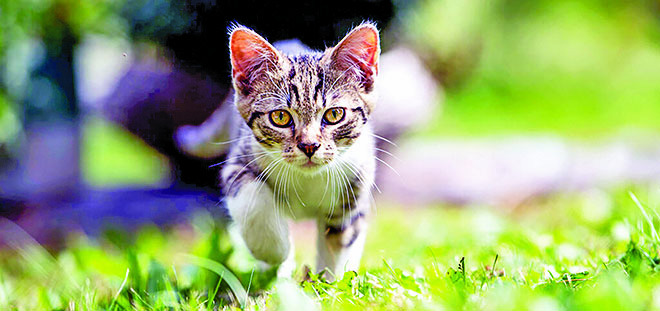PET TALK
Cats are hunters by nature, which is why it’s not uncommon for an outdoor cat to bring home a “gift,” left on their owner’s doorstep.
Yet Molly Guyette, a thirdyear Doctor of Veterinary Medicine and veterinary public health and epidemiology master’s student at the Texas A&M School of Veterinary Medicine & Biomedical Sciences (VMBS), says cats put both themselves and local wildlife at risk of injury or illness when they hunt other animals.
“Outdoor cats may only bring home a mouse or bird once every few months, but this is likely a very small reflection of what they are actually up to,” said Guyette, who studies cats and zoonotic diseases, with links to wildlife health, for her master’s research.
As natural predators, cats have natural instincts passed down through generations, Guyette said, that allow them not only to hunt for food to kill and eat but also to kill prey, even if they’re not looking for a meal.
Cats that are free to roam outdoors, including domestic house cats, can invade and harm native ecosystems, as they generally hunt any small animal, including rabbits, birds, and lizards.
“Research has estimated that as many as 4 billion birds, 22.3 billion mammals, and 1.1 billion amphibians and reptiles are killed by free-roaming cats per year in the United States,” Guyette said. “Domestic cats have also been implicated in the extinction of at least 63 species of birds, mammals, and reptiles.”
Direct contact is not the only way that cats can negatively affect wildlife, either.
“Simply the presence of a cat within an ecosystem can cause disturbances in a bird’s ability to forage, feed their young, and defend themselves from other predators,” Guyette said. “The No. 1 method of preventing this wildlife predation by cats is to keep cats indoors.”
It can be difficult, however, for owners to keep their furry friends indoors and away from local wildlife since cats have a natural inclination to the outdoors.
In this case, Guyette recommends owners take measures to protect nearby animals by outfitting cats with an “alarm system” such as a collar with a bell.
Owners also should consider why their cat is outdoors, as this impacts what additional measures should be taken.
“If your cat loves the outdoors, lying in the sun, or playing in the grass, you should let them do so either in an enclosure or leashed and under direct supervision,” she said. “If cats are kept outdoors due to unwanted behaviors, such as scratching, not urinating and defecating in appropriate areas, or acting aggressively, owners should discuss options with a veterinarian for managing such behaviors and helping their cats feel more comfortable inside.”
Encouraging cats to stay indoors is also to their own benefit, as cats put themselves in danger when exploring the great outdoors.
“Cats that freely roam live a significantly shorter lifespan compared to cats that live inside – only 2-5 years compared to the lifespan of an indoor cat of 10-20 years,” Guyette said.
The short lifespan is due to several factors, such as contracting illnesses from other animals; picking up worms, fleas, or ticks; or being injured or killed by cars or wildlife, including coyotes and dogs.
Regardless of a cat’s typical living arrangement, owners should have a veterinarian vaccinate them against disease- causing organisms that can be transmitted between cats, wildlife, and, in many cases, humans.
One such disease is rabies, for which cats are required by state laws to be vaccinated.
“Preventing the spread of rabies is of utmost importance because the rabies virus can easily spread through bites or scratches from infected animals, leading to neurological signs (like seizures or paralysis) and death,” Guyette said. “Typical suspects that are at a higher risk for transmitting rabies to cats include bats, skunks, foxes, coyotes, and raccoons.”
Another disease that can spread between cats, wildlife, and humans is toxoplasmosis, caused by the parasite Toxoplasma gondii, the symptoms of which include fever, fatigue, and, if left untreated, may lead to eye damage.
“Cats are critical in the transmission of toxoplasmosis because the disease requires a cat as part of its life cycle,” Guyette said.
Cats become infected when they consume an infected host, such as a rodent or infected raw meat. Infected cats shed the parasite for less than two weeks, but if the parasite matures for more than 24 hours in cat feces, it can become infectious to others, particularly pregnant or immunocompromised people.
Finally, external (fleas and ticks) and internal (roundworms and heartworms) parasites can transmit disease between cats and wildlife.
“Outdoor cats come into contact with more parasites in the environment and can contribute more to the spread of internal parasites as compared to indoor-only cats,” she said. “Outdoor cats can also spread to other cats a disease called feline leukemia, a highly contagious virus that can lead to a lifelong suppressed immune system.”
Free-roaming cats can incite danger for both wildlife and themselves. To protect them, reduce the spread of contagious illnesses, and give them the chance at a longer, healthier life, owners should consider methods for keeping their lovable felines at home.
Pet Talk is a service of the School of Veterinary Medicine & Biomedical Sciences, Texas A&M University. Stories can be viewed on the web at vetmed.tamu.edu/news/pettalk. Suggestions for future topics may be directed to [email protected].







Comment
Comments